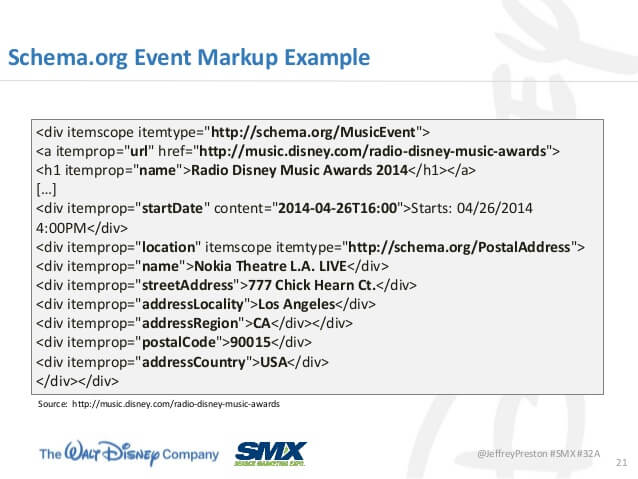In follow-up to our recent recap of SMX Advanced, I wanted to expand and share some takeaways from an SEO perspective. As always, the SMX team did a fantastic job of assembling a stellar lineup of experts to share industry insights and predictions in the world of search and Search Engine Optimisation.

From an SEO perspective, two things really stood out:
- Schema markup and the impact it has on robots crawling online media
- G+ is here to stay!
Here’s why.
Schema Markup – Pleasing the Robots!
As we know, websites are typically built with the focus placed squarely on user experience and making sure that they provide high-quality content in the best format possible. When done well, this helps businesses build their digital footprint as thought leaders, helping them earn trust and establish authority within their product and/or service arenas.
That’s great, but how is this information organised and how will it fit moving forward into the semantic search space?
Enter the Search Bots!
The search bots are no different than human visitors. They want to understand what a site is about in a clear and concise way so they can organise and generate the best web pages in the search results. To help with this process, schema markup is more commonly being used to label specific ‘information or content’ on a page to help the bots quickly identify what the content is about.
A full ninety-minute session based on schema markup and how it has impacted larger sites such as Best Buy and Disney really sparked my interest as the presenters dove into great detail on how they are using it to make sure the search bots not only understand the information on the page, but that they understand it in a thematic way.
In the following example, Disney has used the semantic markup in a thematic and logical manner so the information is presented to bots in an orderly way that not only makes sense to them but also to us as humans.
What stood out to me was their approach and how they looked at and spoke about schema markup. It was almost like a conversation between man and robot.
Disney: “Hey Robot, this page is about an ‘event’. The event’s title is ‘Radio Disney Music Awards’, the date of the awards is ‘April, 26, 2014’, the location of the awards is ‘L.A.’ and more specifically it is located at this address” ‘777 Chick Hearn Ct.’”.
This ‘conversational’ approach allows us to naturally understand what schema markup tags are needed and how we should chronologically organise them on the page.
Provided that website pages house quality content, well organised thematic schema markup will make it easier for the bots to highlight and identify important information, help them logically understand what the website is about and, more importantly, allow them to present the marked up information in the knowledge graph.
The key takeaway is not to add schema markup for markup’s sake, but to organise it in a way that is thematic in nature to better help the robots understand what the page is truly about. Just like humans, the robots want to view information in a way that makes sense.
![]()
G+ is Here to Stay
The second big SEO nugget was Google’s announcement around Google My Business, the one-stop shop for small businesses, allowing them to manage and connect with customers via search, maps and Google+. In Google’s own words they want businesses to “engage with customers”, “be found” online and have “insights” into how your content and website is performing.
The main backbone to Google My Business is the G+ platform. Like it or not, G+ is here to stay. In my opinion, Google will strategically use Google My Business as a way to help them understand more about people and businesses. It is this information that will be used and incorporated into Google’s semantic search and knowledge graph.
Why use Google My Business?
Search engine visibility: Need I say more? G+ and authorship is in its early days. However, it is going to have a big impact on how businesses are found online. Google wants to transform the web of websites into a web full of people. To do this they need to have a strong incentive for people to use the G+ platform and search visibility is a great way to do it.
Measuring content engagement: Many businesses today are struggling to measure the impact of their content and social engagements. With Google Insights, businesses will be able to see how their content is performing via the way people are interacting with their posts from a Google and search perspective. This interaction is what will give business and marketers an edge into understanding how their audience is engaging with specific topics and content pieces put online.
Building an audience: The future of organic search is about building and engaging with audiences. To help do this, Google has made it easy for businesses to gain a following on the G+ profile by allowing people to follow a person or a business from not only the G+ platform but also from embedded posts on your own website. Further proof of the need to build an audience can be found directly in the search results, where the ‘authorship profiles’ that appear show the number of people who have you in their circles. By creating great content and encouraging audience engagement you not only increase your brand’s reputation but also the number people who follow you and want to hear what you have to say.
In short, Google My Business is the heart of local businesses’ Google experience, and the new dashboard will only help make it easier for them to use while allowing them to understand what is truly going on with their online content and search reach.
Robots, G+ or Both?
Search and social are continuously changing; however, they are slowly merging together to become one. With Google as the main search engine and G+ at the heart of their user experience, we can start to see the importance of incorporating both schema markup for increased search visibility and the G+ platform’s promising future as a viable online marketing tool.
Ryan Henry, Director of SEO
Interested in finding out more? Contact DAC today!



